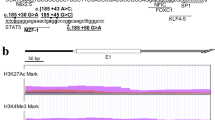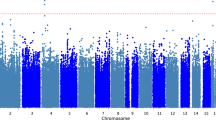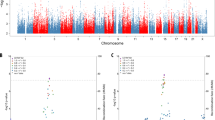Abstract
RGS2 (regulator of G-protein signaling 2) modulates dopamine receptor signal transduction. Functional variants in the gene may influence susceptibility to extrapyramidal symptoms (EPS) induced by antipsychotic drugs. To further investigate our previous report of association of the RGS2 gene with susceptibility to antipsychotic-induced EPS, we performed a replication study. EPS were rated in 184 US patients with schizophrenia (115 African Americans, 69 Caucasian) treated for at least a month with typical antipsychotic drugs (n=45), risperidone (n=46), olanzapine (n=50) or clozapine (n=43). Six single nucleotide polymorphisms (SNPs) within or flanking RGS2 were genotyped (rs1933695, rs2179652, rs2746073, rs4606, rs1819741 and rs1152746). Odds ratios (ORs) and 95% confidence intervals (CIs) were calculated by logistic regression. Our results indicate association of SNP rs4606 with antipsychotic-induced parkinsonism (AIP), as measured by the Simpson Angus scale, in the overall sample and in the African-American subsample, the G (minor) allele having a protective effect. ORs for AIP among rs4606 G-allele carriers were 0.23 (95% CI 0.10–0.54, P=0.001) in the overall sample, and 0.20 (0.07–0.57, P=0.003) in the African-American subsample. In the previously studied Israeli sample the OR was 0.31 (0.11–0.84, P=0.02). We completely sequenced the RGS2 gene in nine patients with AIP and nine patients without, from the Israeli sample. No common coding polymorphisms or additional regulatory variants were revealed, suggesting that association of the rs4606 C/G polymorphism with AIP is biologically meaningful and not a consequence of linkage disequilibrium with another functional variant. Taken together, the findings of the current study support the association of RGS2 with AIP and focus on a possible protective effect of the minor G allele of SNP rs4606. This SNP is located in the 3′-regulatory region of the gene, and is known to influence RGS2 mRNA levels and protein expression.
This is a preview of subscription content, access via your institution
Access options
Subscribe to this journal
Receive 6 print issues and online access
$259.00 per year
only $43.17 per issue
Buy this article
- Purchase on Springer Link
- Instant access to full article PDF
Prices may be subject to local taxes which are calculated during checkout

Similar content being viewed by others
References
Blanchet PJ . Antipsychotic drug-induced movement disorders. Can J Neurol Sci 2003; 30 (Suppl 1): S101–S107.
Reynolds GP . Receptor mechanisms in the treatment of schizophrenia. J Psychopharmacol 2004; 18: 340–345.
Lindenmayer JP, Eerdekens E, Berry SA, Eerdekens M . Safety and efficacy of long-acting risperidone in schizophrenia: a 12-week, multicenter, open-label study in stable patients switched from typical and atypical oral antipsychotics. J Clin Psychiatry 2004; 65: 1084–1089.
Park S, Ross-Degnan D, Adams AS, Sabin J, Kanavos P, Soumerai SB . Effect of switching antipsychotics on antiparkinsonian medication use in schizophrenia: population-based study. Br J Psychiatry 2005; 187: 137–142.
Hirose G . Drug induced parkinsonism: a review. J Neurol 2006; 253 (Suppl 3): iii22–iii24.
Lerner V, Libov I, Kapstan A, Miodownik C, Dwolatzky T, Levine J . The prevalence of neuroleptic drug-induced tardive movement subsyndromes among schizophrenic and schizoaffective patients residing in the southern region of Israel. Isr J Psychiatry Relat Sci 2007; 44: 20–28.
Arranz MJ, de Leon J . Pharmacogenetics and pharmacogenomics of schizophrenia: a review of last decade of research. Mol Psychiatry 2007; 12: 707–747.Jun 5; e-pub ahead of print.
Greenbaum L, Strous RD, Kanyas K, Merbl Y, Horowitz A, Karni O et al. Association of the RGS2 gene with extrapyramidal symptoms (EPS) induced by treatment with antipsychotic medication. Pharmacogenet Genomics 2007; 17: 519–528.
Semplicini A, Lenzini L, Sartori M, Papparella I, Calò LA, Pagnin E et al. Reduced expression of regulator of G-protein signaling 2 (RGS2) in hypertensive patients increases calcium mobilization and ERK1/2 phosphorylation induced by angiotensin II. J Hypertens 2006; 24: 1115–1124.
Hollinger S, Hepler JR . Cellular regulation of RGS proteins: modulators and integrators of G protein signaling. Pharmacol Rev 2002; 54: 527–559.
Taymans JM, Leysen JE, Langlois X . Striatal gene expression of RGS2 and RGS4 is specifically mediated by dopamine D1 and D2 receptors: clues for RGS2 and RGS4 functions. J Neurochem 2003; 84: 1118–1127.
Ghavami A, Hunt RA, Olsen MA, Zhang J, Smith DL, Kalgaonkar S et al. Differential effects of regulator of G protein signaling (RGS) proteins on serotonin 5-HT1A, 5-HT2A, and dopamine D2 receptor-mediated signaling and adenylyl cyclase activity. Cell Signal 2004; 16: 711–721.
Bernstein LS, Ramineni S, Hague C, Cladman W, Chidiac P, Levey AI et al. RGS2 binds directly and selectively to the M1 muscarinic acetylcholine receptor third intracellular loop to modulate Gq/11alpha signaling. J Biol Chem 2004; 279: 21248–21256.
Potenza MN, Gold SJ, Roby-Shemkowitz A, Lerner MR, Nestler EJ . Effects of regulators of G protein-signaling proteins on the functional response of the mu-opioid receptor in a melanophore-based assay. J Pharmacol Exp Ther 1999; 291: 482–491.
Yalcin B, Willis-Owen SA, Fullerton J, Meesaq A, Deacon RM, Rawlins JN et al. Genetic dissection of a behavioral quantitative trait locus shows that Rgs2 modulates anxiety in mice. Nat Genet 2004; 36: 1197–1202.
Heximer SP, Knutsen RH, Sun X, Kaltenbronn KM, Rhee MH, Peng N et al. Hypertension and prolonged vasoconstrictor signaling in RGS2-deficient mice. J Clin Invest 2003; 111: 445–452.
Leygraf A, Hohoff C, Freitag C, Willis-Owen SA, Krakowitzky P, Fritze J et al. Rgs 2 gene polymorphisms as modulators of anxiety in humans? J Neural Transm 2006; 113: 1921–1925.
Gabriel SB, Schaffner SF, Nguyen H, Moore JM, Roy J, Blumenstiel B et al. The structure of haplotype blocks in the human genome. Science 2002; 296: 2225–2229.
Chen JM, Férec C, Cooper DN . A systematic analysis of disease-associated variants in the 3′ regulatory regions of human protein-coding genes I: general principles and overview. Hum Genet 2006; 120: 1–21.
Casey DE . Pathophysiology of antipsychotic drug-induced movement disorders. J Clin Psychiatry 2004; 65 (Suppl): 25–28.
Miyamoto S, Duncan GE, Marx CE, Lieberman JA . Treatments for schizophrenia: a critical review of pharmacology and mechanisms of action of antipsychotic drugs. Mol Psychiatry 2005; 10: 79–104.
Ho G, Wang Y, Jones PG, Young KH . Activation of serum response element by D2 dopamine receptor is governed by Gbetagamma-mediated MAPK and Rho pathways and regulated by RGS proteins. Pharmacology 2007; 79: 114–121.
Stanwood GD, Parlaman JP, Levitt P . Genetic or pharmacological inactivation of the dopamine D1 receptor differentially alters the expression of regulator of G-protein signalling (RGS) transcripts. Eur J Neurosci 2006; 24: 806–818.
Taymans JM, Kia HK, Groenewegen HJ, Leysen JE, Langlois X . Bilateral control of brain activity by dopamine D1 receptors: evidence from induction patterns of regulator of G protein signaling 2 and c-fos mRNA in D1-challenged hemiparkinsonian rats. Neuroscience 2005; 134: 643–656.
Tovey SC, Willars GB . Single-cell imaging of intracellular Ca2+ and phospholipase C activity reveals that RGS 2, 3, and 4 differentially regulate signaling via the Galphaq/11-linked muscarinic M3 receptor. Mol Pharmacol 2004; 66: 1453–1464.
Robinet EA, Geurts M, Maloteaux JM, Pauwels PJ . Chronic treatment with certain antipsychotic drugs preserves upregulation of regulator of G-protein signalling 2 mRNA in rat striatum as opposed to c-fos mRNA. Neurosci Lett 2001; 307: 45–48.
Fatemi SH, Reutiman TJ, Folsom TD, Bell C, Nos L, Fried P et al. Chronic olanzapine treatment causes differential expression of genes in frontal cortex of rats as revealed by DNA microarray technique. Neuropsychopharmacology 2006; 31: 1888–1899.
Smith R, Lindenmayer J-P, Bark N, Warner-Cohen J, Vaidhyanathaswamy S, Khandat A . Clozapine, risperidone, olanzapine, and conventional antipsychotic drug effects on glucose, lipids, and leptin in schizophrenic patients. Int J Neuropsychopharmacol 2005; 8: 183–194.
Kay S, Fiszbein A, Opler LA . The Positive And Negative Syndrome scale for schizophrenia. Schizophr Bull 1987; 13: 261–276.
Simpson G, Angus MP . Scale for assessment extrapyramidal side effects. Acta Psychiatr Scand 1970; 212: 11–19.
Barnes TR . A rating scale for drug induced akathisia. Br J Psychiatry 1989; 154: 672–676.
Rozen S, Skaletsky H . Primer3 on the WWW for general users and for biologist programmers.In: Krawetz S, Misener S (eds). Bioinformatics Methods and Protocols: Methods in Molecular Biology 2000. Humana Press: Totowa, NJ.pp. 365–386.
Stephens M, Smith NJ, Donnelly P . A new statistical method for haplotype reconstruction from population data. Am J Hum Genet 2001; 68: 978–989.
Stephens M, Donnelly P . A comparison of Bayesian methods for haplotype reconstruction from population genotype data. Am J Hum Genet 2003; 73: 1162–1169.
Acknowledgements
This study was supported in part by internal funds from Hadassah Medical Organisation (to BL) and by an Independent Investigator Grant from Eli Lily (to RCS).
Author information
Authors and Affiliations
Corresponding author
Additional information
Duality of interest
The authors have no competing interests.
Rights and permissions
About this article
Cite this article
Greenbaum, L., Smith, R., Rigbi, A. et al. Further evidence for association of the RGS2 gene with antipsychotic-induced parkinsonism: protective role of a functional polymorphism in the 3′-untranslated region. Pharmacogenomics J 9, 103–110 (2009). https://doi.org/10.1038/tpj.2008.6
Received:
Revised:
Accepted:
Published:
Issue Date:
DOI: https://doi.org/10.1038/tpj.2008.6
Keywords
This article is cited by
-
RGS2 expression predicts amyloid-β sensitivity, MCI and Alzheimer’s disease: genome-wide transcriptomic profiling and bioinformatics data mining
Translational Psychiatry (2016)
-
Association of common genetic variants with risperidone adverse events in a Spanish schizophrenic population
The Pharmacogenomics Journal (2013)
-
Association of two DRD2 gene polymorphisms with acute and tardive antipsychotic-induced movement disorders in young Caucasian patients
Psychopharmacology (2012)
-
Association of the ZFPM2 gene with antipsychotic-induced parkinsonism in schizophrenia patients
Psychopharmacology (2012)
-
A common variant in DRD3 gene is associated with risperidone-induced extrapyramidal symptoms
The Pharmacogenomics Journal (2009)



